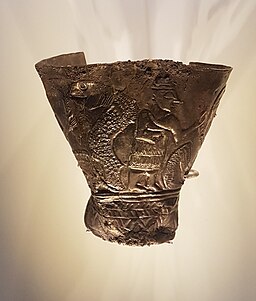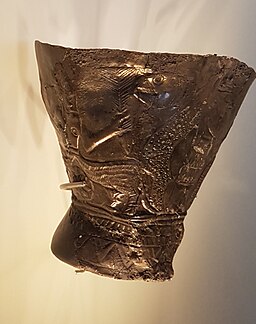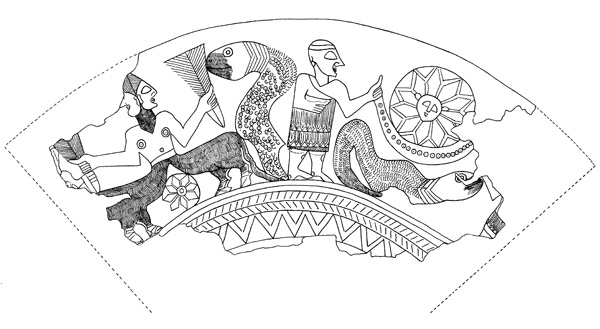A silver goblet discovered more than five decades ago in the Judean Hills has emerged from decades of scholarly debate with a startling new interpretation: the 4,300-year-old vessel contains the earliest known visual depiction of cosmic creation, predating Babylon’s famous creation myth by more than a millennium.

The chalice from Ain Samia (Photo via Wikimedia Commons)
The ˁAin Samiya goblet, barely three inches tall, was unearthed in 1970 from a burial site in the hills of Judea. For decades, scholars largely accepted the interpretation of legendary Israeli archaeologist Yigael Yadin—who also served as the IDF’s second chief of staff—that the vessel’s intricate engravings illustrated the Babylonian Enuma Elish creation myth. That interpretation never sat comfortably with the evidence. The Enuma Elish dates to around 1200 BCE, over a thousand years after the goblet was crafted during the Intermediate Bronze Age (2650-1950 BCE).

The chalice from Ain Samia (Photo via Wikimedia Commons)
A new study published Thursday in the peer-reviewed Journal of the Ancient Near Eastern Society Ex Oriente Lux presents a different answer. The goblet depicts not the violent cosmic warfare of Babylonian myth, but a peaceful transformation from primordial chaos to ordered creation—a narrative that resonates with the opening chapter of the Bible itself.
The vessel’s two sides tell a sequential story. One scene shows a human torso merged with two bull bodies, clutching palm fronds and hovering above a small sun while confronting a menacing serpent. The opposite side depicts two figures carrying a crescent-shaped object topped by a sun, with the same serpent now lying defeated beneath their feet.
The key to unlocking the goblet’s meaning, according to lead author Dr. Eberhard Zangger, a Swiss geoarchaeologist, lies in that crescent-shaped object: a celestial boat. “The boat has a practical purpose: it’s a vehicle that transports celestial bodies across the sky,” Zangger explained. This “boat of light” ensures the sun and moon maintain their courses, creating day and night, seasons, and lunar phases—the fundamental rhythms of creation itself.
The division between chaos and order appears throughout ancient Near Eastern cosmology. The Bible records: “God said, ‘Let there be light,’ and there was light. God saw that the light was good, and God separated the light from the darkness” (Genesis 1:3-4). While the goblet’s imagery differs from the biblical account—featuring gods, chimeras, and celestial vessels rather than the God of Israel speaking creation into existence—both narratives share the theme of order emerging from chaos, light banishing darkness.
“The goblet does not tell of a violent struggle between gods, but of a peaceful process of cosmic ordering,” said Daniel Sarlo, who co-authored the study. “It shows how the Sun is born, banishes chaos and renews the world.”
The goblet was the only luxury item found in its tomb, discovered alongside 16 ceramic vessels, three four-spout lamps, an arrowhead, a spear shaft, and amber beads. The researchers theorize the silver vessel—a rare commodity in the southern Levant—was crafted in northern Syria, possibly by an artisan from the Akkadian Empire, before making its way to the Judean Hills.
To support their interpretation, the researchers point to a previously unpublished artifact: a 3,800-year-old prism excavated in the 1980s at Lidar Höyük in Turkey. The prism bears similar cosmological imagery, including a celestial boat, strengthening the theory that these symbols formed part of a shared ancient understanding of creation across the Near East.
Not all scholars accept the new interpretation. Mark Smith, a biblical scholar at Princeton Theological Seminary, suggests the goblet could reflect other ancient narratives, including the Baal Cycle. “I think the objection to assuming that it’s a Babylonian creation story is correct, but it’s not clear that this is a creation myth at all,” Smith said.
Susan Cohen, an archaeologist at Montana State University specializing in the Bronze Age Levant, warns against drawing firm conclusions from such a unique object. Without additional context about how and why the goblet was produced and buried, definitive interpretation remains elusive.
The goblet resides in the Israel Museum on permanent loan from the Civil Administration, which conducted the original excavations. Whether it represents humanity’s oldest visual record of creation or serves some other purpose, the artifact stands as testimony to the ancient world’s preoccupation with the ultimate question: how did order emerge from chaos, and light from darkness? That the Bible’s answer—spoken by the God of Israel—differs from the polytheistic imagery on this ancient cup makes the parallel themes all the more striking. Both ancient Judeans and their neighbors wrestled with the same cosmic mystery, even as they arrived at vastly different conclusions about its source.




